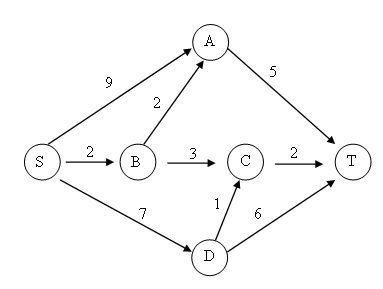Street Network
(CAT
2006)
A significant amount of traffic
flows from point S to point T in the one-way street network shown below. Points
A, B, C, and D are junctions in the network, and the arrows mark the direction
of traffic flow. The fuel cost in rupees for travelling along a street is
indicated by the number adjacent to the arrow representing the street.
Motorists travelling from point S
to point T would obviously take the route for which the total cost of
travelling is the minimum. If two or more routes have the same least travel
cost, then motorists are indifferent between them. Hence, the traffic gets
evenly distributed among all the least cost routes.
The government can control the
flow of traffic only by levying appropriate toll at each junction. For example,
if a motorist takes the route S-A-T (using junction A alone), then the total
cost of travel would be Rs 14 (i.e., Rs 9 + Rs 5) plus the toll charged at
junction A.
1. If the government wants to
ensure that no traffic flows on the street from D to T, while equal amount of
traffic flows through junctions A and C, then a feasible set of toll charged
(in rupees) at junctions A, B, C, and D respectively to achieve this goal is:
a. 1,5,3,3
b. 1,4,4,3
c. 1,5,4,2
d. 0,5,2,3
e. 0,5,2,2
2. If the government wants to
ensure that all motorists travelling from S to T pay the same amount (fuel
costs and toll combined) regardless of the route they choose and the street
from B to C is under repairs (and hence unusable), then a feasible set of toll
charged (in rupees) at junctions A, B, C, and D respectively to achieve this
goal is:
a. 2,5,3,2
b. 0,5,3, 1
c. 1,5,3,2
d. 2,3,5,1
e. 1,3,5,1
3. If the government wants to
ensure that the traffic at S gets evenly distributed along streets from S to A,
from S to B, and from S to D, then a feasible set of toll charged (in rupees)
at junctions A, B, C, and D respectively to achieve this goal is:
a. 0,5,4,1
b. 0,5,2,2
c. 1,5,3,3
d. 1,5,3,2
e. 0,4,3,2
4. If the government wants to
ensure that all routes from S to T get the same amount of traffic, then a
feasible set of toll charged (in rupees) at junctions A, B, C, and D
respectively to achieve this goal is:
a. 0,5,2,2
b. 0,5,4,1
c. 1,5,3,3
d. 1,5,3,2
e.1,5,4,2
5. The government wants to devise
a toll policy such that the total cost to the commuters per trip is minimized.
The policy should also ensure that not more than 70 per cent of the total
traffic passes through junction B. The cost incurred by the commuter travelling
from point S to point T under this policy will be:
a. Rs. 7
b. Rs. 9
c. Rs. 10
d. Rs. 13
e. Rs. 14
For answers click here

Comments
Post a Comment